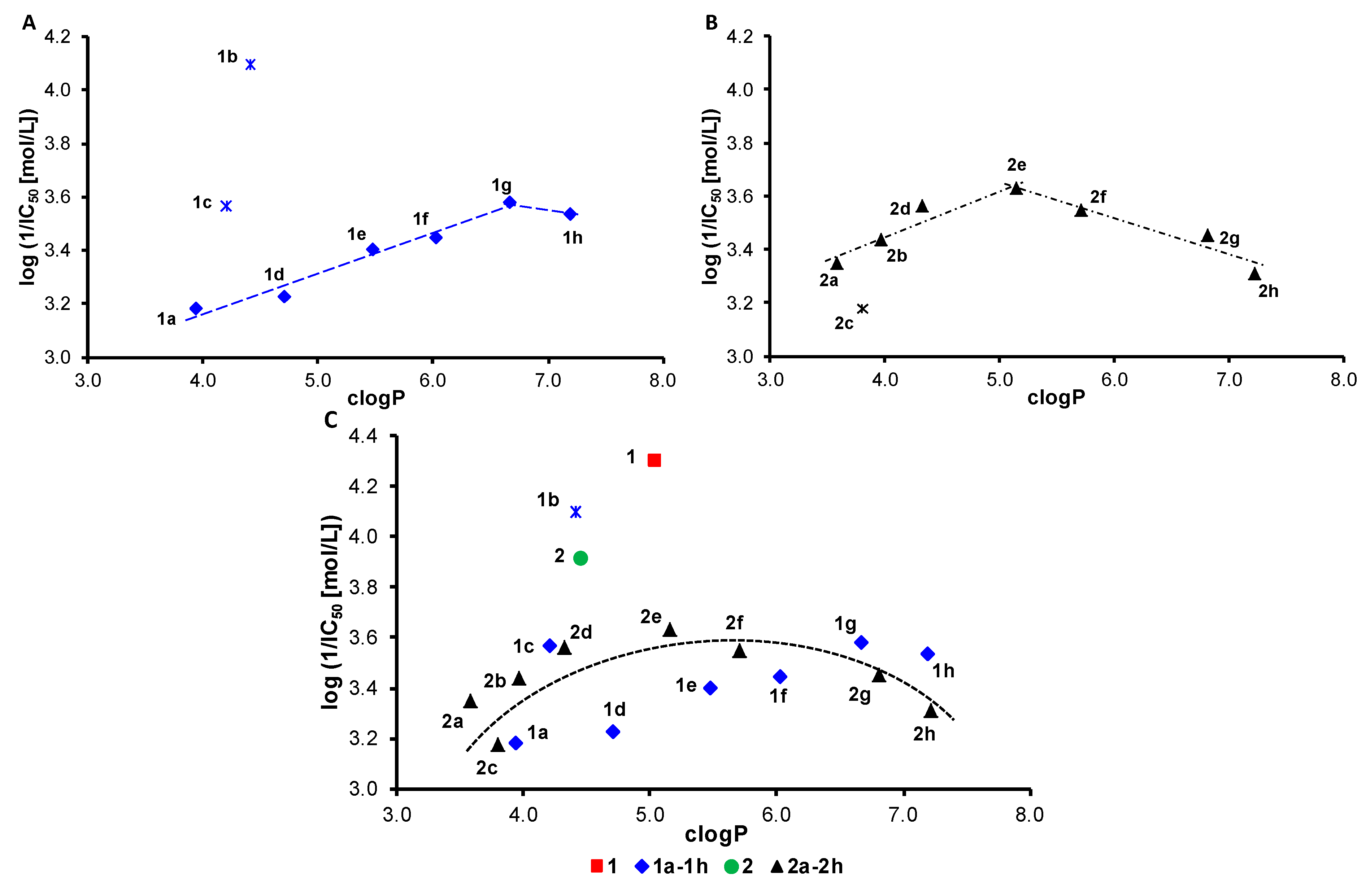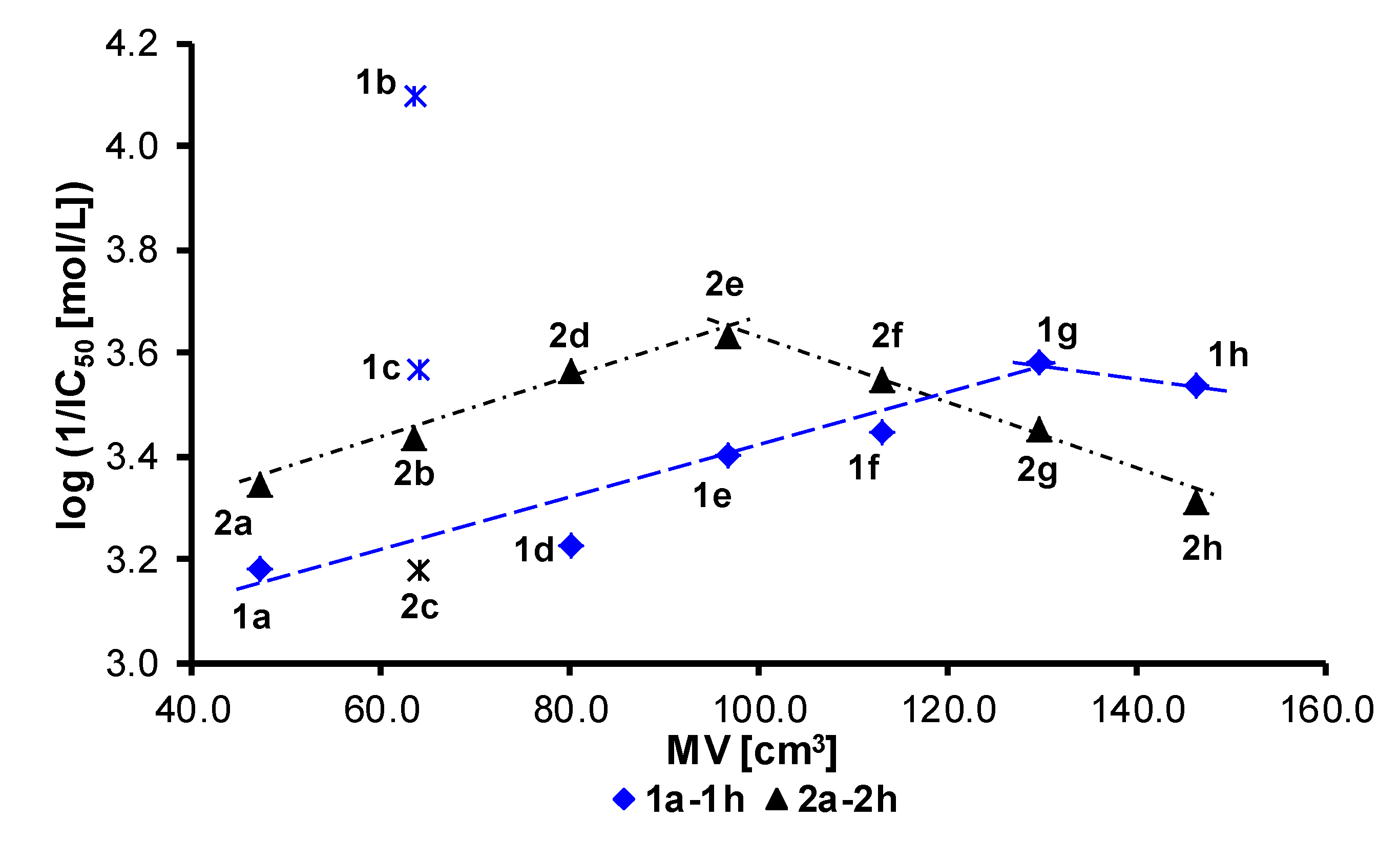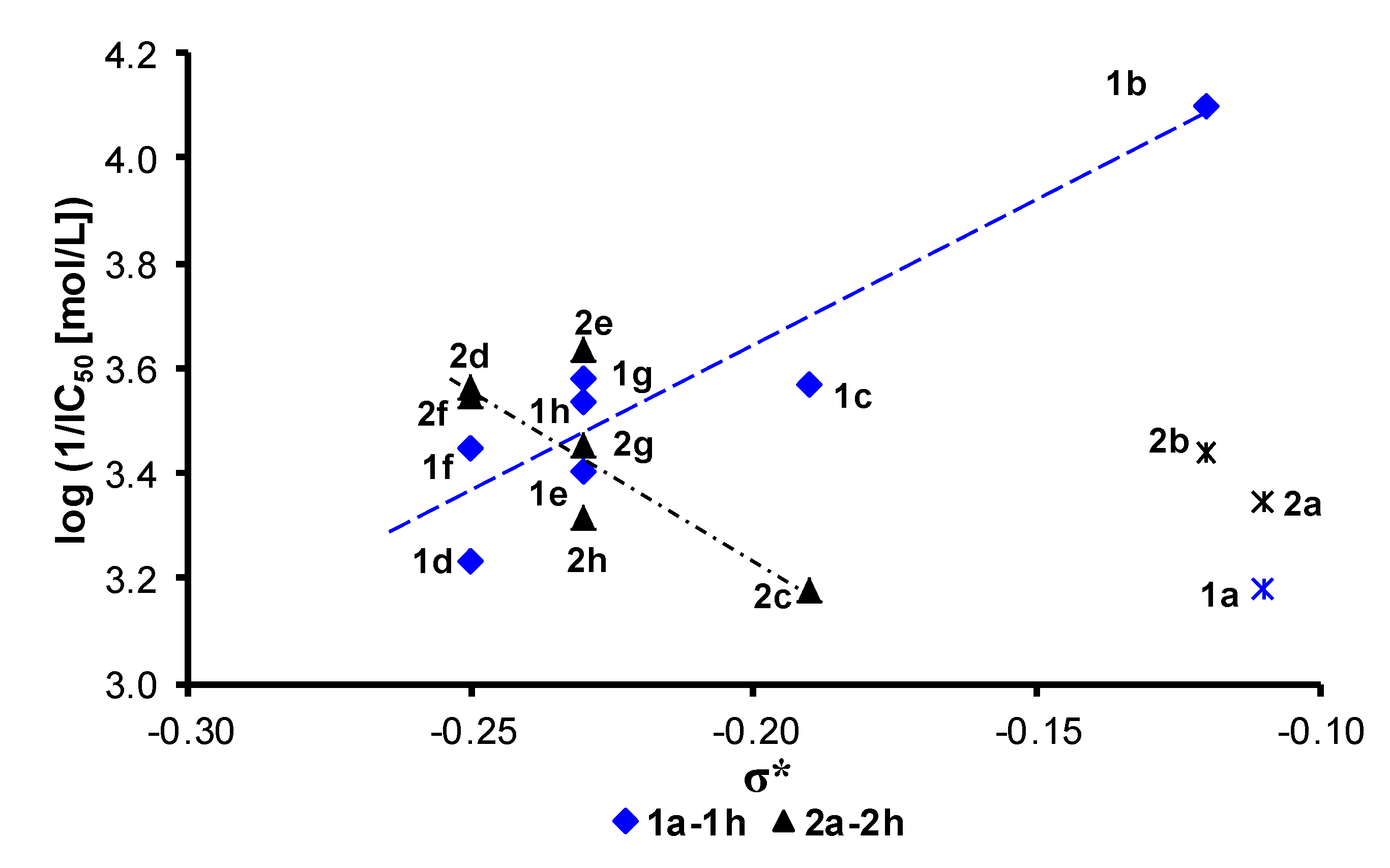Photosynthesis-Inhibiting Activity of 1-[(2-Chlorophenyl)carbamoyl]- and 1-[(2-Nitrophenyl)carbamoyl]naphthalen-2-yl Alkylcarbamates †
Abstract
:1. Introduction
2. Results and Discussion
2.1. Chemistry
2.2. Inhibition of Photosynthetic Electron Transport (PET) in Spinach Chloroplasts
3. Experimental Section
3.1. Synthesis
3.2. Study of Photosynthetic Electron Transport (PET) Inhibition in Spinach Chloroplasts
3.3. Statistical Analysis
4. Conclusions
Acknowledgments
Author Contributions
Conflicts of Interest
References and Notes
- Roth, H.J.; Fenner, H. Arzneistoffe, 3rd ed.; Deutscher Apotheker Verlag: Stuttgart, Germany, 2000. [Google Scholar]
- Kumar, S.; Kumar, P.; Sati, N. Synthesis and biological evaluation of Schiff bases and azetidinones of 1-naphthol. J. Pharm. Bioallied Sci. 2012, 4, 246–249. [Google Scholar] [CrossRef] [PubMed]
- Rokade, Y.B.; Sayyed, R.Z. Naphthalene derivatives: A new range of antimicrobials with high therapeutic value. Rasayan J. Chem. 2009, 2, 972–980. [Google Scholar]
- Durrant, J.D.; Hall, L.; Swift, R.V.; Landon, M.; Schnaufer, A.; Schnaufer, A.; Amaro, R.E. Novel naphthalene-based inhibitors of Trypanosoma brucei RNA editing ligase 1. Plos Negl. Trop. Dis. 2010, 4, e803. [Google Scholar] [CrossRef] [PubMed]
- Parineeta, B.N. Derivatives of 1-chloromethyl naphthalene: Synthesis and microbiological evaluation as potential antifungal agents. Der Pharma Chem. 2011, 3, 105–111. [Google Scholar]
- Kanno, T.; Tanaka, A.; Shimizu, T.; Nakano, T.; Nishizaki, T. 1-[2-(2-Methoxyphenylamino)ethylamino]-3-(naphthalene-1-yloxy)propan-2-ol as a potential anticancer drug. Pharmacology 2013, 91, 339–345. [Google Scholar] [CrossRef] [PubMed]
- Damu, G.L.V.; Wang, Q.P.; Zhang, H.Z.; Zhang, Y.Y.; Lv, J.S.; Zhou, C.H. A series of naphthalimide azoles: Design, synthesis and bioactive evaluation as potential antimicrobial agents. Sci. Chin. Chem. 2013, 56, 952–969. [Google Scholar] [CrossRef]
- Kauerova, T.; Kos, J.; Gonec, T.; Jampilek, J.; Kollar, P. Antiproliferative and pro-apoptotic effect of novel nitro-substituted hydroxynaphthanilides on human cancer cell lines. Int. J. Mol. Sci. 2016, 17, 1219. [Google Scholar] [CrossRef] [PubMed]
- Evans, B.E.; Rittle, K.E.; Bock, M.G.; DiPardo, R.M.; Freidinger, R.M.; Whitter, W.L.; Lundell, G.F.; Veber, D.F.; Anderson, P.S. Methods for drug discovery: Development of potent, selective, orally effective cholecystokinin antagonists. J. Med. Chem. 1988, 31, 2235–2246. [Google Scholar] [CrossRef] [PubMed]
- Patchett, A.A.; Nargund, R.P. Chapter 26. Privileged structures—An update. Annu. Rep. Med. Chem. 2000, 35, 289–298. [Google Scholar]
- Klekota, J.; Roth, F.P. Chemical substructures that enrich for biological activity. Bioinformatics 2008, 24, 2518–2525. [Google Scholar] [CrossRef] [PubMed]
- Ji, T.; Lee, M.; Pruitt, S.C.; Hangauer, D.G. Privileged scaffolds for blocking protein-protein interactions: 1,4-disubstituted naphthalene antagonists of transcription factor complex HOX-PBX/DNA. Bioorg. Med. Chem. Lett. 2004, 14, 3875–3879. [Google Scholar] [CrossRef] [PubMed]
- Gonec, T.; Bobal, P.; Sujan, J.; Pesko, M.; Guo, J.; Kralova, K.; Pavlacka, L.; Vesely, L.; Kreckova, E.; Kos, J.; et al. Investigating the spectrum of biological activity of substituted quinoline-2-caboxamides and their isosteres. Molecules 2012, 17, 613–644. [Google Scholar] [CrossRef] [PubMed]
- Kos, J.; Zadrazilova, I.; Pesko, M.; Keltosova, S.; Tengler, J.; Gonec, T.; Bobal, P.; Kauerova, T.; Oravec, M.; Kollar, P.; et al. Antibacterial and herbicidal activity of ring-substituted 3-hydroxynaphthalene-2-carboxanilides. Molecules 2013, 18, 7977–7997. [Google Scholar] [CrossRef] [PubMed]
- Gonec, T.; Kos, J.; Zadrazilova, I.; Pesko, M.; Govender, R.; Keltosova, S.; Chambel, B.; Pereira, D.; Kollar, P.; Imramovsky, A.; et al. Antibacterial and herbicidal activity of ring-substituted 2-hydroxynaphthalene-1-carboxanilides. Molecules 2013, 18, 9397–9419. [Google Scholar] [CrossRef] [PubMed]
- Gonec, T.; Kos, J.; Zadrazilova, I.; Pesko, M.; Keltosova, S.; Tengler, J.; Bobal, P.; Kollar, P.; Cizek, A.; Kralova, K.; et al. Antimycobacterial and herbicidal activity of ring-substituted 1-hydroxynaphthalene-2-carboxanilides. Bioorg. Med. Chem. 2013, 21, 6531–6541. [Google Scholar] [CrossRef] [PubMed]
- Gonec, T.; Kos, J.; Nevin, E.; Govender, R.; Pesko, M.; Tengler, J.; Kushkevych, I.; Stastna, V.; Oravec, M.; Kollar, P.; et al. Preparation and biological properties of ring-substituted naphthalene-1-carboxanilides. Molecules 2014, 19, 10386–10409. [Google Scholar] [CrossRef] [PubMed]
- Gonec, T.; Zadrazilova, I.; Nevin, E.; Kauerova, T.; Pesko, M.; Kos, J.; Oravec, M.; Kollar, P.; Coffey, A.; O’Mahony, J.; et al. Synthesis and biological evaluation of N-alkoxyphenyl-3-hydroxynaphthalene-2-carboxanilides. Molecules 2015, 20, 9767–9787. [Google Scholar] [CrossRef] [PubMed]
- Kos, J.; Nevin, E.; Soral, M.; Kushkevych, I.; Gonec, T.; Bobal, P.; Kollar, P.; Coffey, A.; O’Mahony, J.; Liptaj, T.; et al. Synthesis and antimycobacterial properties of ring-substituted 6-hydroxynaphthalene-2-carboxanilides. Bioorg. Med. Chem. 2015, 23, 2035–2043. [Google Scholar] [CrossRef] [PubMed]
- Jampilek, J.; Clements, C.; Kos, J.; Gonec, T.; Gray, A.I. Synthesis and in vitro anti-trypanosomal screening of hydroxynaphthalene-2-carboxanilides. In Proceedings of the 6th Conversatory on Medicinal Chemistry, Lublin, Poland, 18–20 September 2014; p. 24 (K5). [Google Scholar]
- Gonec, T.; Pospisilova, S.; Kauerova, T.; Kos, J.; Dohanosova, J.; Oravec, M.; Kollar, P.; Coffey, A.; Liptaj, T.; Cizek, A.; et al. N-Alkoxyphenylhydroxynaphthalenecarboxamides and their antimycobacterial activity. Molecules 2016, 21, 1068. [Google Scholar] [CrossRef] [PubMed]
- Gonec, T.; Pospisilova, S.; Holanova, L.; Stranik, J.; Cernikova, A.; Pudelkova, V.; Kos, J.; Oravec, M.; Kollar, P.; Cizek, A.; et al. Synthesis and antimicrobial evaluation of 1-[(2-substituted phenyl)carbamoyl]naphthalen-2-yl carbamates. Molecules 2016, 21, 1189. [Google Scholar] [CrossRef] [PubMed]
- Jampilek, J.; Brychtova, K. Azone analogues: Classification, design, and transdermal penetration principles. Med. Res. Rev. 2012, 32, 907–947. [Google Scholar] [CrossRef] [PubMed]
- Laursen, J.S.; Engel-Andreasen, J.; Fristrup, P.; Harris, P.; Olsen, C.A. Cis-trans amide bond rotamers in β-peptoids and peptoids: Evaluation of stereoelectronic effects in backbone and side chains. J. Am. Chem. Soc. 2013, 135, 2835–2844. [Google Scholar] [CrossRef] [PubMed] [Green Version]
- Zadrazilova, I.; Pospisilova, S.; Pauk, K.; Imramovsky, A.; Vinsova, J.; Cizek, A.; Jampilek, J. In vitro bactericidal activity of 4- and 5-chloro-2-hydroxy-N-[1-oxo-1-(phenylamino)alkan-2-yl]-benzamides against MRSA. BioMed Res. Int. 2015, 2015, 349534. [Google Scholar] [CrossRef] [PubMed]
- Zadrazilova, I.; Pospisilova, S.; Masarikova, M.; Imramovsky, A.; Monreal-Ferriz, J.; Vinsova, J.; Cizek, A.; Jampilek, J. Salicylanilide carbamates: Promising antibacterial agents with high in vitro activity against methicillin-resistant Staphylococcus aureus. Eur. J. Pharm. Sci. 2015, 77, 197–207. [Google Scholar] [CrossRef] [PubMed]
- Good, N.E. Inhibitors of the Hill reaction. Plant Physiol. 1961, 36, 788–803. [Google Scholar] [CrossRef] [PubMed]
- Kralova, K.; Sersen, F.; Cizmarik, J. Inhibitory effect of piperidinoethylesters of alkoxyphenylcarbamic acids on photosynthesis. Gen. Physiol. Biophys. 1992, 11, 261–267. [Google Scholar]
- Kralova, K.; Sersen, F.; Kubicova, L.; Waisser, K. Inhibitory effects of substituted benzanilides on photosynthetic electron transport in spinach chloroplasts. Chem. Pap. 1999, 53, 328–331. [Google Scholar] [CrossRef]
- Kralova, K.; Sersen, F.; Kubicova, L.; Waisser, K. Inhibition of photosynthetic electron transport in spinach chloroplasts by 3- and 4-halogeno substituted benzanilides and thiobenzanilides. J. Trace Microprobe Technol. 2000, 18, 251–256. [Google Scholar]
- Musiol, R.; Tabak, D.; Niedbala, H.; Podeszwa, B.; Jampilek, J.; Kralova, K.; Dohnal, J.; Finster, J.; Mencel, A.; Polanski, J. Investigating biological activity spectrum for novel quinoline analogues 2: Hydroxyquinolinecarboxamides with photosynthesis inhibiting activity. Bioorg. Med. Chem. 2008, 16, 4490–4499. [Google Scholar] [CrossRef] [PubMed]
- Otevrel, J.; Mandelova, Z.; Pesko, M.; Guo, J.; Kralova, K.; Sersen, F.; Vejsova, M.; Kalinowski, D.; Kovacevic, Z.; Coffey, A.; et al. Investigating the spectrum of biological activity of ring-substituted salicylanilides and carbamoylphenylcarbamates. Molecules 2010, 15, 8122–8142. [Google Scholar] [CrossRef] [PubMed]
- Imramovsky, A.; Pesko, M.; Monreal-Ferriz, J.; Kralova, K.; Vinsova, J.; Jampilek, J. Photosynthesis-inhibiting efficiency of 4-chloro-2-(chlorophenylcarbamoyl)phenyl alkyl-carbamates. Bioorg. Med. Chem. Lett. 2011, 21, 4564–4567. [Google Scholar] [CrossRef] [PubMed]
- Kralova, K.; Perina, M.; Waisser, K.; Jampilek, J. Structure-activity relationships of N-benzylsalicylamides for inhibition of photosynthetic electron transport. Med. Chem. 2015, 11, 156–164. [Google Scholar] [CrossRef] [PubMed]
- Jampilek, J.; Kralova, K.; Pesko, M.; Kos, J. Ring-substituted 8-hydroxyquinoline-2-carbox-anilides as photosystem II inhibitors. Bioorg. Med. Chem. Lett. 2016, 26, 3862–3865. [Google Scholar]
- Draber, W.; Tietjen, K.; Kluth, J.F.; Trebst, A. Herbicides in photosynthesis research. Angew. Chem. 1991, 3, 1621–1633. [Google Scholar] [CrossRef]
- Tischer, W.; Strotmann, H. Relationship between inhibitor binding by chloroplasts and inhibition of photosynthetic electron-transport. Biochim. Biophys. Acta 1977, 460, 113–125. [Google Scholar] [CrossRef]
- Trebst, A.; Draber, W. Structure activity correlations of recent herbicides in photosynthetic reactions. In Advances in Pesticide Science; Greissbuehler, H., Ed.; Pergamon Press: Oxford, UK, 1979; pp. 223–234. [Google Scholar]
- Bowyer, J.R.; Camilleri, P.; Vermaas, W.F.J. Herbicides, Topics in Photosynthesis; Baker, N.R., Percival, M.P., Eds.; Elsevier: Amsterdam, The Netherlands, 1991; Volume 10, pp. 27–85. [Google Scholar]
- Izawa, S. Acceptors and donors for chloroplast electron transport. In Methods in Enzymology; Part C; Colowick, P., Kaplan, N.O., Eds.; Academic Press: New York, NY, USA; London, UK, 1980; Volume 69, pp. 413–434. [Google Scholar]
- Pattabiraman, V.R.; Bode, J.W. Rethinking amide bond synthesis. Nature 2011, 480, 471–479. [Google Scholar] [CrossRef] [PubMed]
- Ghosh, A.K.; Brindisi, M. Organic carbamates in drug design and medicinal chemistry. J. Med. Chem. 2015, 58, 2895–2940. [Google Scholar] [CrossRef] [PubMed]
- Williamson, R.L.; Metcalf, R.L. Salicylanilides: A new group of active uncouplers of oxidative phosphorylation. Science 1967, 158, 1694–1695. [Google Scholar] [CrossRef] [PubMed]
- Renger, G. The action of 5-chloro-3-tert-butyl-2′-chloro-4′-nitro-salicylanilide and α,α-bis(hexafluoroacetonyl)aceton on the water-splitting enzyme system Y in spinach chloroplasts. FEBS Lett. 1975, 52, 30–32. [Google Scholar] [CrossRef]
- Black, C.C. Photosynthetic phosphorylation and associated reactions in the presence of a new group of uncouplers: Salicylanilides. Biochim. Biophys. Acta 1968, 162, 294–296. [Google Scholar] [CrossRef]
- Jampilek, J.; Dolezal, M.; Kunes, J.; Buchta, V.; Silva, L.; Kralova, K. Quinaldine derivatives: Preparation and biological activity. Med. Chem. 2005, 1, 591–599. [Google Scholar] [CrossRef] [PubMed]
- Musiol, R.; Jampilek, J.; Kralova, K.; Richardson, D.R.; Kalinowski, D.; Podeszwa, B.; Finster, J.; Niedbala, H.; Palka, A.; Polanski, J. Investigating biological activity spectrum for novel quinoline analogues. Bioorg. Med. Chem. 2007, 15, 1280–1288. [Google Scholar] [CrossRef] [PubMed]
- Jampilek, J. Potential of agricultural fungicides for antifungal drug discovery. Expert Opin. Drug Dis. 2016, 11, 1–9. [Google Scholar] [CrossRef] [PubMed]
- Imramovsky, A.; Pesko, M.; Jampilek, J.; Kralova, K. Synthesis and photosynthetic electron transport inhibition of 2-substituted 6-fluorobenzothiazoles. Monatsh. Chem. 2014, 145, 1817–1824. [Google Scholar] [CrossRef]
- Norrington, F.E.; Hyde, R.M.; Williams, S.G.; Wootton, R. Physiochemical-activity relations in practice. 1. A rational and self-consistent data bank. J. Med. Chem. 1975, 18, 604–607. [Google Scholar] [CrossRef] [PubMed]
- Pesko, M.; Kos, J.; Kralova, K.; Jampilek, J. Inhibition of Photosynthetic Electron Transport by 6-Hydroxynaphthalene-2-carboxanilides. Indian J. Chem. B 2015, 54B, 1511–1517. [Google Scholar]
- Balgavy, P.; Devinsky, F. Cut-off effects in biological activities of surfactants. Adv. Colloid Interface 1996, 66, 23–63. [Google Scholar] [CrossRef]
- Przestalski, S.; Sarapuk, J.; Kleszczynska, H.; Gabrielska, J.; Hladyszowski, J.; Trela, Z.; Kuczera, J. Influence of amphiphilic compounds on membranes. Acta Biochim. Pol. 2000, 47, 627–638. [Google Scholar] [PubMed]
- Sarapuk, J.; Kubica, K. Cut-off phenomenon. Cell. Mol. Biol. Lett. 1998, 5, 261–269. [Google Scholar]
- Kralova, K.; Sersen, F.; Sidoova, E. Effects of 2-alkylthio-6-aminobenzothiazoles and their 6-N-substituted derivatives on photosynthesis inhibition in Chlorella vulgaris and spinach chloroplasts. Gen. Phys. Biophys. 1993, 12, 421–427. [Google Scholar]
- Kralova, K.; Sersen, F.; Miletin, M.; Hartl, J. Inhibition of photosynthetic electron transport by some anilides of 2-alkylpyridine-4-carboxylic acids in spinach chloroplasts. Chem. Pap. 1998, 52, 52–58. [Google Scholar] [CrossRef]
- Kralova, K.; Sersen, F. Long chain bisquaternary ammonium salts-effective inhibitors of photosynthesis. Tenside Surfactant Deterg. 1994, 31, 192–194. [Google Scholar]
- Kralova, K.; Sersen, F.; Devinsky, F.; Lacko, I. Photosynthesis-inhibiting effects of cationic biodegradable gemini surfactants. Tenside Surfactant Deterg. 2010, 47, 288–293. [Google Scholar] [CrossRef]
- Kralova, K.; Sersen, F.; Klimesova, V.; Waisser, K. 2-Alkylsulphanyl-4-pyridine-carbothioamides–inhibitors of oxygen evolution in freshwater alga Chlorella vulgaris. Chem. Pap. 2011, 65, 909–912. [Google Scholar] [CrossRef]
- Masarovicova, E.; Kralova, K. Approaches to measuring plant photosynthesis activity. In Handbook of Photosynthesis, 2nd ed.; Pessarakli, M., Ed.; Taylor & Francis Group: Boca Raton, FL, USA, 2005; pp. 617–656. [Google Scholar]
Sample Availability: Samples of compounds 1–2h are available from author T. Gonec. |




 | ||||||
|---|---|---|---|---|---|---|
| Comp. | R1 | R2 | clogP ‡ | MVR2 ‡ [cm3] | σ*R2 ‡ | PET Inhibition IC50 [mmol/L] |
| 1 | Cl | — | 5.03 | — | — | 0.049 ± 0.002 a |
| 1a | Cl | –C2H5 | 3.94 | 47.29 | -0.11 | 0.659 ± 0.046 j |
| 1b | Cl | –C3H7 | 4.41 | 63.80 | -0.12 | 0.080 ± 0.002 a |
| 1c | Cl | –CH(CH3)2 | 4.20 | 64.18 | -0.19 | 0.271 ± 0.010 d |
| 1d | Cl | –C4H9 | 4.71 | 80.31 | -0.25 | 0.589 ± 0.031 i |
| 1e | Cl | –C5H11 | 5.47 | 96.81 | -0.23 | 0.396 ± 0.017 f |
| 1f | Cl | –C6H13 | 6.03 | 113.32 | -0.25 | 0.358 ± 0.013 e |
| 1g | Cl | –C7H15 | 6.67 | 129.83 | -0.23 | 0.263 ± 0.009 c,d |
| 1h | Cl | –C8H17 | 7.19 | 146.33 | -0.23 | 0.290 ± 0.010 d |
| 2 | NO2 | — | 4.45 | — | — | 0.121 ± 0.004 b |
| 2a | NO2 | –C2H5 | 3.58 | 47.29 | -0.11 | 0.450 ± 0.022 g |
| 2b | NO2 | –C3H7 | 3.96 | 63.80 | -0.12 | 0.365 ± 0.017 e,f |
| 2c | NO2 | –CH(CH3)2 | 3.80 | 64.18 | -0.19 | 0.664 ± 0.041 j |
| 2d | NO2 | –C4H9 | 4.32 | 80.31 | -0.25 | 0.274 ± 0.012 d |
| 2e | NO2 | –C5H11 | 5.15 | 96.81 | -0.23 | 0.233 ± 0.008 c |
| 2f | NO2 | –C6H13 | 5.71 | 113.32 | -0.25 | 0.283 ± 0.012 d |
| 2g | NO2 | –C7H15 | 6.81 | 129.83 | -0.23 | 0.352 ± 0.018 e |
| 2h | NO2 | –C8H17 | 7.22 | 146.33 | -0.23 | 0.487 ± 0.027 h |
| DCMU | — | — | — | — | — | 0.002 |
© 2017 by the authors. Licensee MDPI, Basel, Switzerland. This article is an open access article distributed under the terms and conditions of the Creative Commons Attribution (CC BY) license (http://creativecommons.org/licenses/by/4.0/).
Share and Cite
Gonec, T.; Stranik, J.; Pesko, M.; Kos, J.; Oravec, M.; Kralova, K.; Jampilek, J. Photosynthesis-Inhibiting Activity of 1-[(2-Chlorophenyl)carbamoyl]- and 1-[(2-Nitrophenyl)carbamoyl]naphthalen-2-yl Alkylcarbamates. Molecules 2017, 22, 1199. https://doi.org/10.3390/molecules22071199
Gonec T, Stranik J, Pesko M, Kos J, Oravec M, Kralova K, Jampilek J. Photosynthesis-Inhibiting Activity of 1-[(2-Chlorophenyl)carbamoyl]- and 1-[(2-Nitrophenyl)carbamoyl]naphthalen-2-yl Alkylcarbamates. Molecules. 2017; 22(7):1199. https://doi.org/10.3390/molecules22071199
Chicago/Turabian StyleGonec, Tomas, Josef Stranik, Matus Pesko, Jiri Kos, Michal Oravec, Katarina Kralova, and Josef Jampilek. 2017. "Photosynthesis-Inhibiting Activity of 1-[(2-Chlorophenyl)carbamoyl]- and 1-[(2-Nitrophenyl)carbamoyl]naphthalen-2-yl Alkylcarbamates" Molecules 22, no. 7: 1199. https://doi.org/10.3390/molecules22071199





